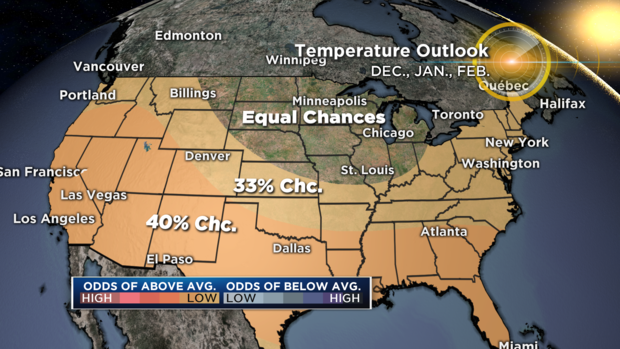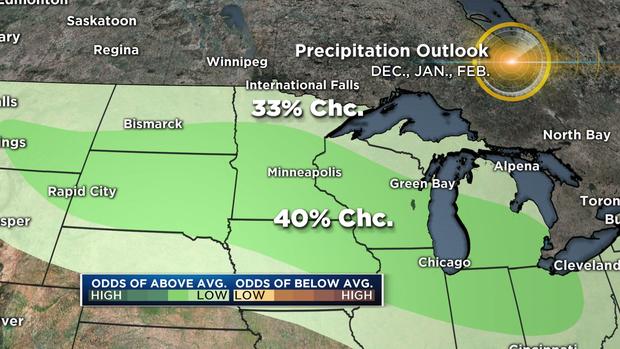NOAA's Winter Outlook Suggests Snowier Than Average Winter In Minnesota
MINNEAPOLIS (WCCO) -- The National Oceanic and Atmospheric Administration has issued its winter outlook, and it suggests that Minnesota can expect a winter with a good chance for more snow than usual.
Minnesota, along with neighboring states, has an equal chance for below-, near- or above-average temperatures, according to NOAA's outlook.
Meanwhile, major sections of the rest of the country outside of the Midwest are forecast to see a higher probability for warmer-than-average temperatures. Alaska and Hawaii see the greatest likelihood for warmer-than-normal conditions. No part of the U.S. is favored to experience below-average temperatures this winter, though some areas see an equal chance for them.
WCCO director of meteorology Mike Augustyniak says there should be a relatively slow start to the season.
"We have not had a frost yet. It doesn't look like it's going to happen in the next one to two week, which already puts us toward the beginning of November," he said.
The NOAA outlook covers the months of December through February, which are considered meteorological winter.
Augustyniak says that NOAA has identified a clear tendency for wetter-than-average winters across the northern U.S. throughout the last few decades.
NOAA acknowledged an absence of El Nino or La Nina, and said that in patterns like this long-term trends become the key predictor for their winter outlook, especially in regard to precipitation.
Week-to-week weather pattern changes, like the Polar Vortex and Arctic Oscillation, are more apt to cause large swings in temperature. The northern portion of the contiguous U.S. is considered the most susceptible to such Arctic outbreaks.
"That's exactly what happened last year, where through the end of January we were tracking to have a much milder than average and relatively snow-free winter," Augustyniak said. "But right at the end of January, the Polar Vortex arrived and created a February that was 8 degrees below average and brought 39 inches of snow. Nobody remembers the warm part of last winter, they only remember what happened at the very tail end."
Mike Halpert, deputy director of NOAA's Climate Prediction Center, characterized this outlook as not being one of the most confident forecasts they have issued. He noted that NOAA did not issue any probabilities above 50% in the continental U.S. as proof of that.
One important thing to note is that this outlook does not project seasonal snowfall accumulations. NOAA notes that snow forecasts are not generally predictable more than a week in advance of snow events.
"Even during a warmer-than-average winter, periods of cold temperatures and snowfall are expected," NOAA's press release informed.
When asked to sum up the outlook in a few words, Augustyniak said, "Snowier than average with wild swings in temperature."
And if that forecast is less than encouraging for those who detest the cold, buckle your seatbelts. The March-April-May outlook is suggesting a slight tilt in the odds toward a colder- and wetter-than-average spring.





